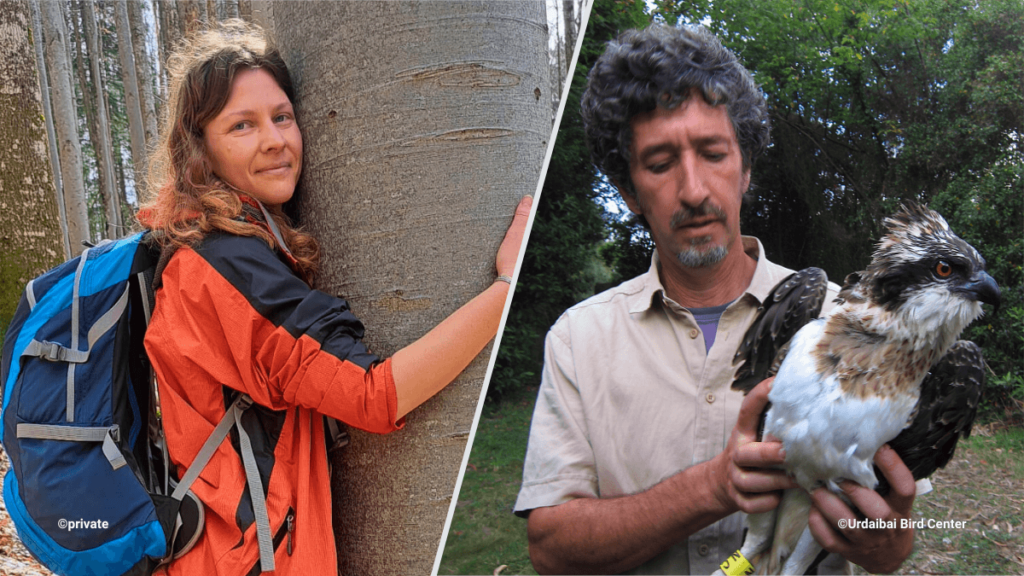How to reintroduce a species that has been extinct for 100 years? And how to make people aware of the natural treasures of their homeland where there are no basic education and protection rules in the protected areas? Our new “Two Rangers, Two Projects” with Maria and Aitor shows how fundamental ranger work is for biodiversity and the basis for nature conservation: involving people. Because ultimately, nature conservation and thus ranger work secures the future of us all.
Maria Gurscaia, volunteer ranger in Moldova, has a professional background as an anthropologist. Out of her concern that nature reserves in Moldova are mainly tourist areas, her background gave her the idea of combining the interpretation of the natural and cultural heritage of these sites to improve nature conservation. Thanks to the joint work of NGOs from Moldova and Czech Republic, Moldova now has its first ranger association with volunteer rangers, aiming to involve people in conservation and create a clear framework for protected areas.
For Aitor Galarza, a ranger from Biscay, Spain, involving people is also a matter which is close to his heart. He led the reintroduction of ospreys in his region and at the same time involved the local population and schools in this project through environmental education.
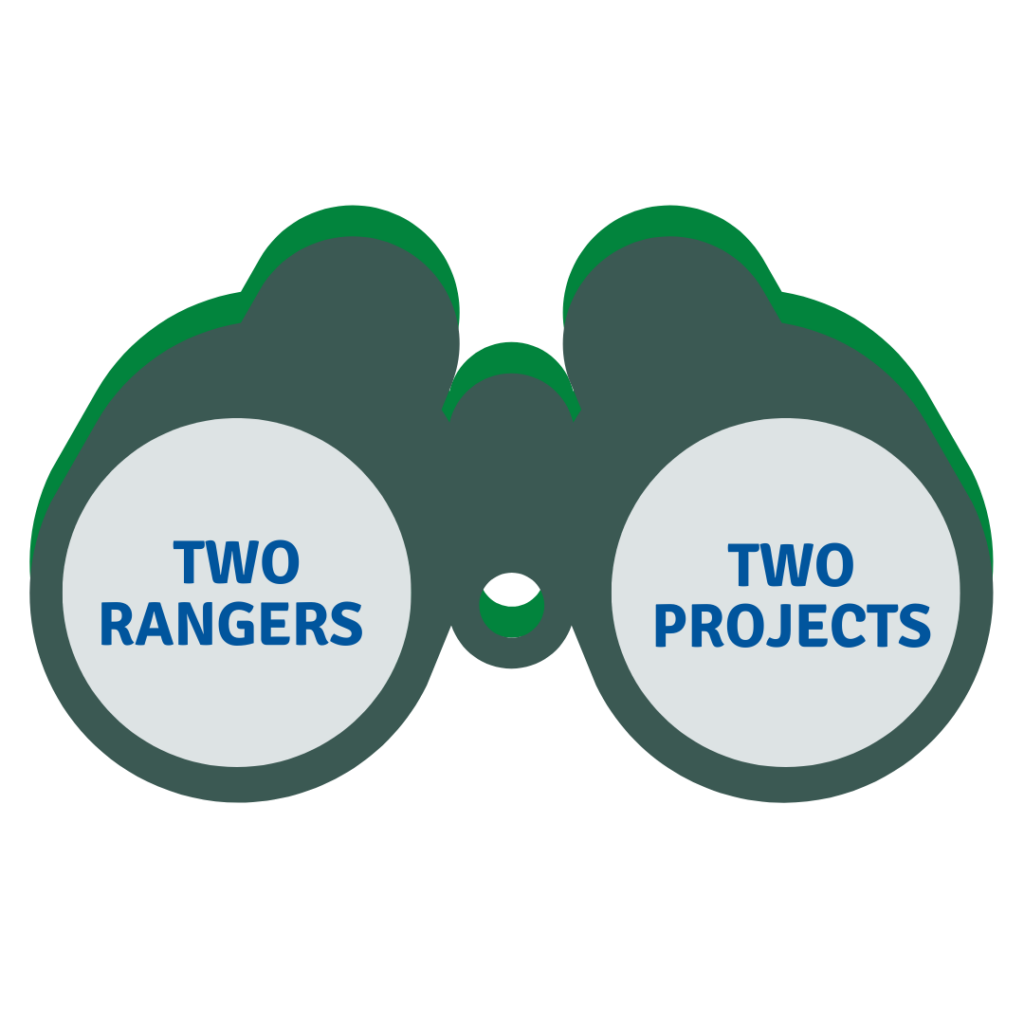
How I became a ranger and got involved in the project
Maria
When I moved to live near a beautiful nature reserve, a famous tourist spot with a canyon, waterfalls, a cave monastery and several archeological sites, I noticed problems such as rubbish left behind by tourists, loud music and other problematic behaviour. So I started small projects with like-minded people.
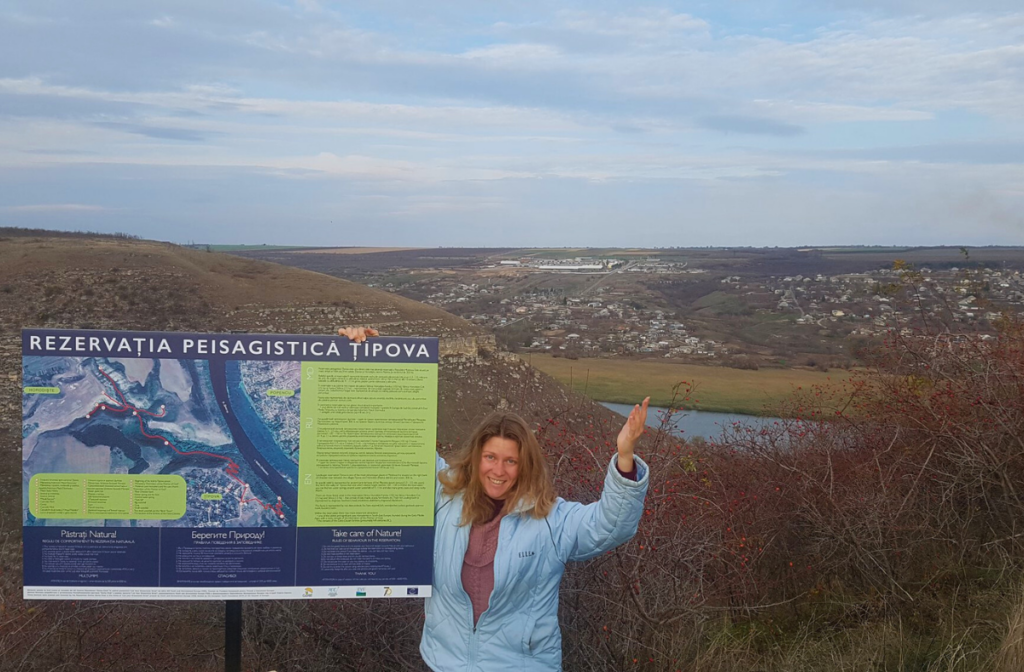
Almost none of the locals and tourists realized that it was a reserve. There was hardly any information and therefore people did not understand the principles of behaviour in this place. In 2019, I put up three first ever information boards for tourists in this area, explaining that it is a nature reserve, informing them about its natural value and encouraging them to behave accordingly. We also educated the local population to sensitise them – gently, to gain their trust. Gradually, in 2020, we founded our own NGO ‘The Center of Regional Development – SOL’ to carry out larger projects. Our first major project, supported by the EU-UNDP, aimed to deal with three nature reserves in Moldova and Transnistria to promote ecotourism and nature conservation. Together we developed online training courses for tourist guides, produced ecotourism brochures, set up additional information boards, designed ecotourism routes, created an information centre and an ecomuseum.
Aitor
I have had a great interest in nature, especially birds, since I was a child. I started getting involved in environmental groups early on, studied biology and completed my degree with a thesis on the birds of Urdaibai, an area that was originally intended to become a tourist magnet after the end of the Franco dictatorship. Fortunately, protests, in which I was also involved, prevented this. I fell in love with the area and when the opportunity arose, I became a ranger at Urdaibai in Basque Country, Northern Spain, some years before it was protected. When I started, the job was all about being environmental police. But when the region was declared a Biosphere reserve 35 years ago, the job of a ranger gradually became more difficult. In addition to being an area with intense forestry activity, which affects both terrestrial and aquatic biodiversity, the reserve is a very touristic place with some beaches and ever new activities in nature that disturb the fauna.
Two birds have always been iconic for me: the white stork and the osprey, which bred in our region a long time ago but now only passed by. That’s why I designed reintroduction projects.
To me, environmental education became more and more important, especially for kids. It became a matter of heart for me to go to schools and teach nature to children. After forty years of work, now nearing retirement, I am satisfied that I have contributed to the conservation of the reserve and provided scientific knowledge about its bird communities. Two birds have always been iconic for me: the white stork and the osprey, which bred in our region a long time ago but now only passed by on their flight to Africa. That’s why I designed reintroduction projects for these birds, and one of my goals has always been to use these processes as tools for environmental awareness.
What the Ranger project is about
Maria
When the pandemic broke out, we faced big problems: three to four times as many tourists leaving rubbish behind, camping and setting fires when we had a severe drought, and other things. We were really overwhelmed, as were the police and environmental inspectors. They were too few to help. But when we asked them for documents that would allow us to officially prosecute misbehaviour, we found out that in Moldova there is the possibility to become volunteer environmental inspectors. Once we had the relevant legitimacy cards, it really helped people to take us seriously and change their behaviour.
Last year we founded the very first Moldovan ranger association. Now we are on the way to become ERF members to be part of the bigger Ranger family.
When we told our co-operation partner, the Czech NGO Arnika, about this, they told us about very good experiences with volunteer rangers. So the Czech NGO Arnika with their partners from the Moldovan NGO E.S. Biotica, our NGO SOL and some other local partners from Moldova and Transnistria started a joint project for environmental inspectors as volunteer rangers in Moldova with support from the Transition programme of the Czech Ministry of Foreign Affairs. As a result, we founded our very first Moldovan ranger association last year: the “Public Association of Voluntary Environmental Inspectors – Rangers”. All this time I didn’t know the concept of rangers, so I was really surprised when I joined the ERF Ranger Training in Romania: What I have been doing all these years was really ranger work: monitoring, patrolling, informing, educating! Now we are on the way to become members of the European Ranger Federation and being part of the bigger Ranger family.
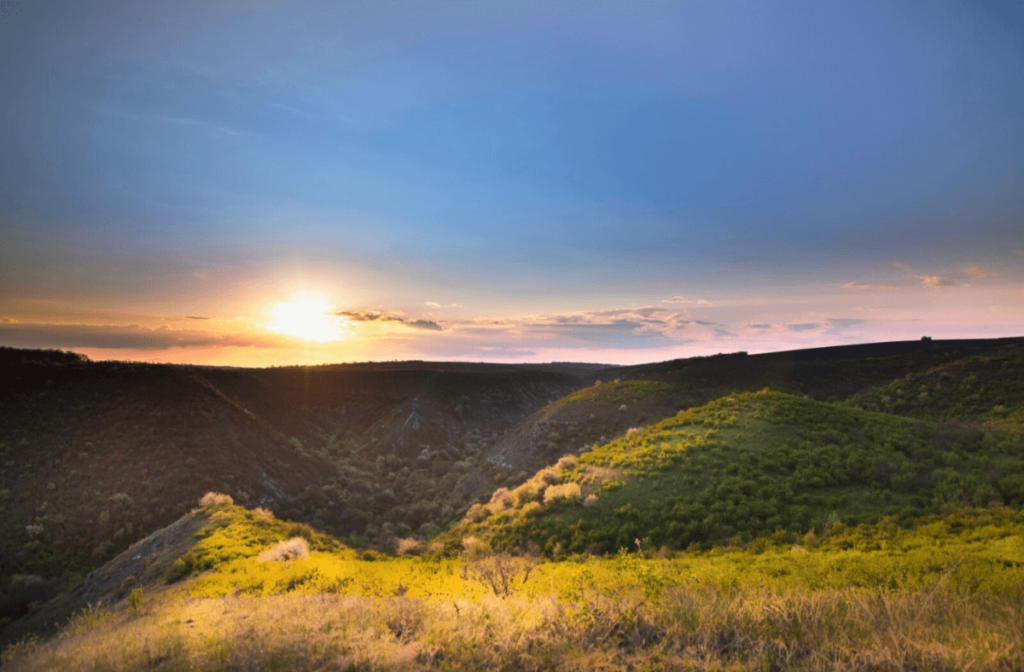
Aitor
One of the most satisfying projects I have been involved in is the reintroduction of the osprey, a bird of prey that became extinct in the north of the Iberian Peninsula about a hundred years ago. The well-known British naturalist, Roy Dennis, contacted me because there was an osprey with a GPS transmitter in my reserve, which was a star in the UK and known to many people as it regularly returned to the British Isles from Africa. I actually found it and continued to exchange information with the naturalist in Scotland.
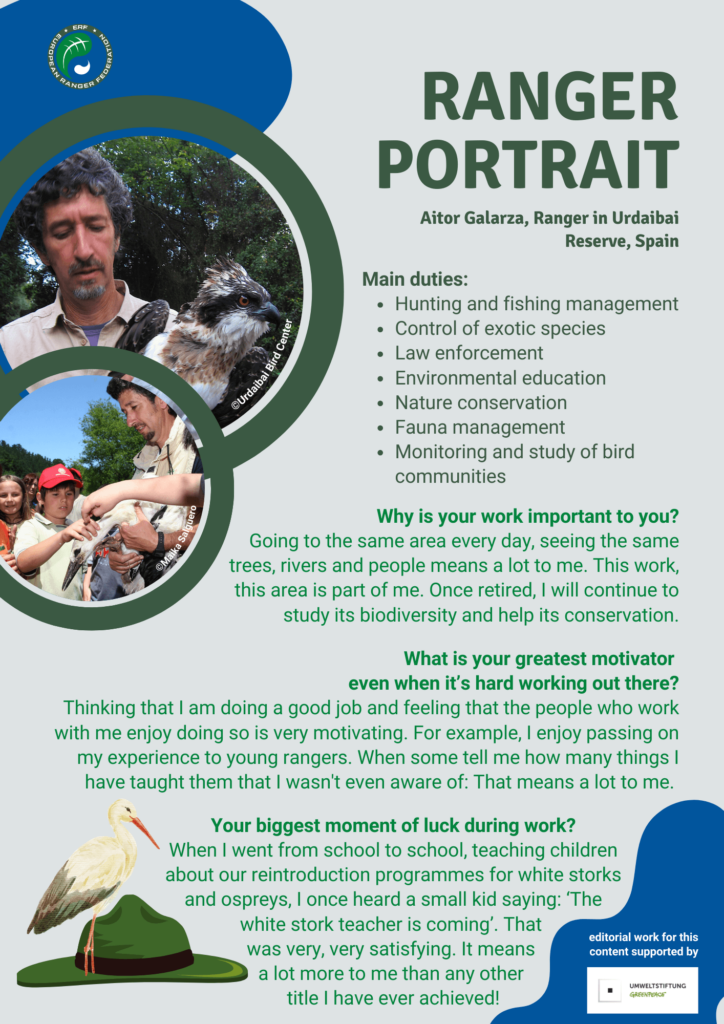
After mutual visits and his advice on the potential success of reintroduction, I organised the permits and plans and worked with a private organization for the logistics. Under a collaborative agreement between Biscay County Council, NatureScot (formerly Scottish Natural Heritage) and the Roy Dennis Wildlife Foundation, I managed the project between 2013 and 2017, travelling to Scotland and bringing chicks to the Basque Country each year. We put them in large cages in a quiet area. After one month, we opened the cages, continued to feed them for a while and then they flew to Africa for the first time. Through this method, known as hacking, they would consider Urdaibai as their birthplace and return to nest. A few years later we were successful!
Challenges, first outcomes and goals
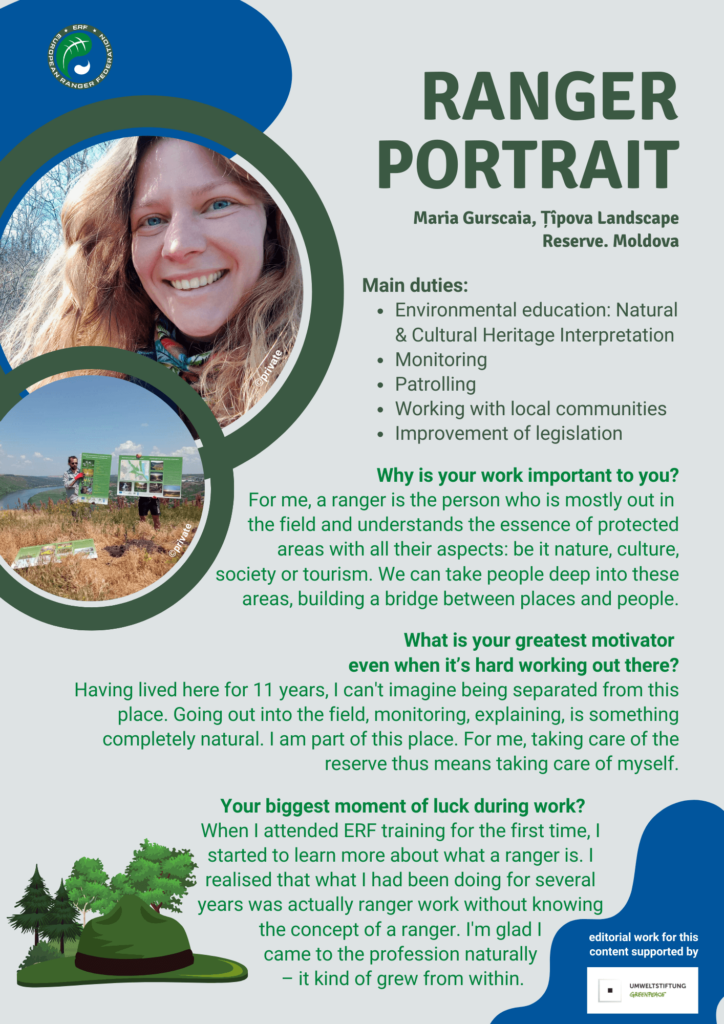
Maria
Most of our nature reserves are more like tourist sites. There is no administration, no clear rules and sometimes even no borders, so there is a lot to do. In addition to the further development of ecotourism routes, we are planning several workshops both for the tourist guides and the volunteer rangers: how to keep the flow of tourists within environmentally friendly limits, how to interpret our reserves’ natural and cultural heritage for its better protection. The biggest challenge for our work is the mentality of the people. The locals are sometimes suspicious of activities in their area and fear that their land will be taken away from them or that they will be displaced. In our post-Soviet region, trust in non-governmental organisations is still not very high. It is therefore important to show them respect and listen to their opinions. However, this must go hand in hand with respect for the principles of nature conservation. We need to explain it to them as well as to tourists by reaching their hearts and their heads, giving information, but also creating a link between them and nature. We are slowly succeeding in raising awareness of natural values in people’s minds. Meanwhile, we are also working with the Environmental Protection Inspectorate and the Ministry of Environment to create or improve official documents and management plans for our nature reserves.
Aitor
Thanks to our work and that of our French colleagues from the nearby Réserve Naturelle du Marais d’Orx, today we have nine birds breeding in the coast of the Bay of Biscay. In total, we brought 60 osprey chicks from Scotland to the Urdaibai reserve.
As popular and charismatic species, the osprey and its reintroduction helps creating environmental awareness. It also advertises the reserve as an ecotourism destination that benefits local communities.
The most important goal was to establish a stable osprey population in our region. The osprey is a popular and charismatic species, which is why the project promotes environmental awareness through environmental education and social networks. It also advertises the Urdaibai Reserve as an ecotourism destination that benefits local communities.As we are located in a densely populated area, people sometimes do not realize that they are in a reserve. Therefore, it is very important that at least the local people are proud of the reserve and love it. Only then will they defend it against any threats. For example, there are plans to build a new, small “Guggenheim” museum in our reserve, just like the big one in Bilbao, near the marsh. Many people are against this and are defending their reserve. This shows how important it is to make people realize the value of nature and its very importance for the future of us all.
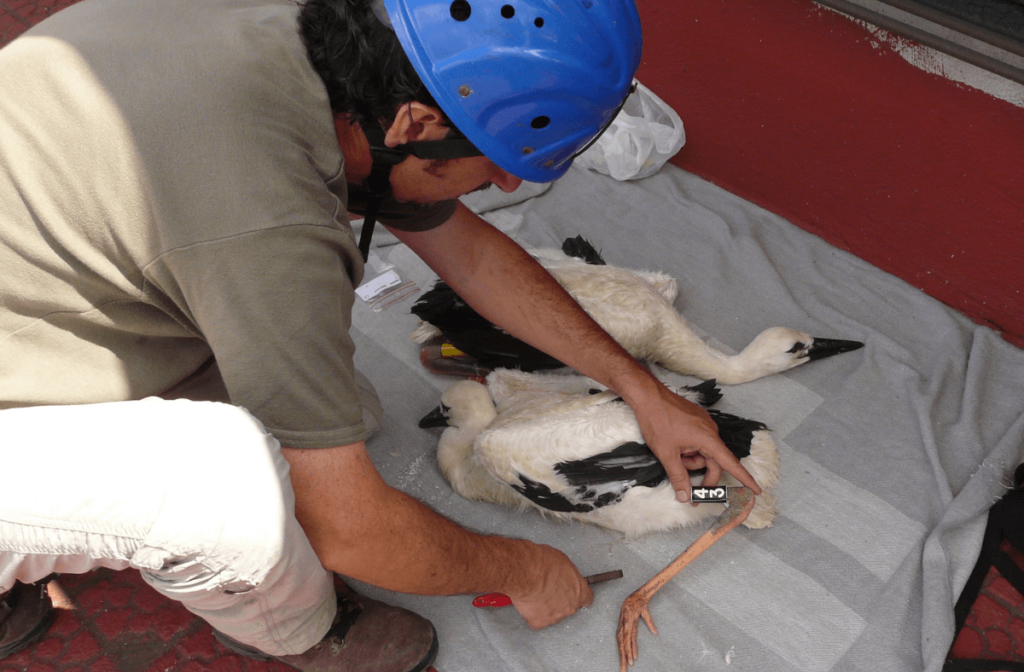
editorial work for this
content is supported by


